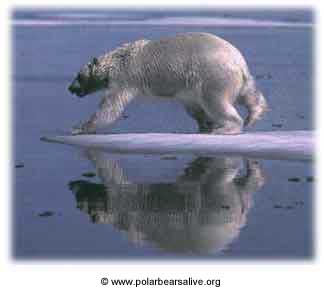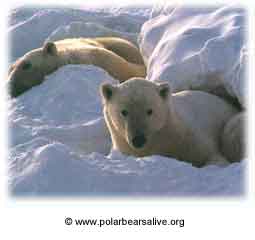Fascinating polar Bears
If there is one particularly impressive land mammal, it is the polar bear. It is not a good idea to come face to face with this animal, because its particularly sharp claws can kill a seal with a single blow of the paw. So be very wary of what may look like, but has nothing to do with a... giant teddy bear! Of course, polar bear rarely attack people. But if despite everything a bear gets it into its head to do so, you will find it very hard to escape from this veritable force of nature that can achieve a top speed of up to 55 km/h and which, once it reaches adult age, weighs between 350 and 500 kg (with the all-time record of... 820 kg!).
King on the ice pack
A polar bear likes to keep to the pack ice. When the spring sees the ice start to break up, a bear may sometimes find itself trapped on an iceberg and may drift hundreds of kilometres to the south with the ice. Or it can swim indefatigably for hours at a cruising speed of 10 km/h.
 When the summer thaw forces it to come back to land, the king of the Far North will eat virtually anything. Eggs, fish, birds, voles, lemmings, fruit and even seaweed - anything will do. Not to mention beached whales that have traditionally provided a feast fit for a king. With a sense of smell that is thought to be a hundred times more developed than our own, no bear who happens to be around will miss out on this opportunity to stuff itself silly. Atttracted by the smell, these large creatures will come and eat up to 45 kg of fat.
When the summer thaw forces it to come back to land, the king of the Far North will eat virtually anything. Eggs, fish, birds, voles, lemmings, fruit and even seaweed - anything will do. Not to mention beached whales that have traditionally provided a feast fit for a king. With a sense of smell that is thought to be a hundred times more developed than our own, no bear who happens to be around will miss out on this opportunity to stuff itself silly. Atttracted by the smell, these large creatures will come and eat up to 45 kg of fat.
In the winter, the polar bear starts hunting as soon as the ice can support its weight. The polar bear's favourite meal? Seal. Either it will find a seal asleep, in which case it will only pounce on its prey and kill it with a powerful blow of the paw after crawling slowly to within 10 to 20 metres of its meal, making sure to stop moving at the slightest movement of the prey, whose poor eyesight can easily confuse an immobile attacker with the remainder of the white environment around him. Or the bear will focus on a single air hole, crouching in front of it, sometimes waiting for hours for a victim to come up unawares for a gulp of air, before clubbing it to death, dragging it out on to the ice and devouring it.
Warrior's rest...
 Despite the fact that it will often sleep for weeks in the dead of winter, the polar bear does not go into deep hibernation. In fact, it prefers to save energy so that it can live for as long as possible on the reserves of fat accumulated during the warm season. Certainly, the bear's heartbeats slow down a little, but its body temperature remains more or less constant. When there is plenty of food, adult males even stay active throughout the entire cold season if it means making up for their days of rest during a relatively frugal period of summer. Usually, though, they disappear for a couple of months. Cubs that have not yet reached the age of "leaving home" will slumber for a hundred or so days. But the female bear can beat the lot of them, sleeping for 115 to 125 days when she has her young with her, and as much as 160 to 170 days during the gestation period.
Despite the fact that it will often sleep for weeks in the dead of winter, the polar bear does not go into deep hibernation. In fact, it prefers to save energy so that it can live for as long as possible on the reserves of fat accumulated during the warm season. Certainly, the bear's heartbeats slow down a little, but its body temperature remains more or less constant. When there is plenty of food, adult males even stay active throughout the entire cold season if it means making up for their days of rest during a relatively frugal period of summer. Usually, though, they disappear for a couple of months. Cubs that have not yet reached the age of "leaving home" will slumber for a hundred or so days. But the female bear can beat the lot of them, sleeping for 115 to 125 days when she has her young with her, and as much as 160 to 170 days during the gestation period.
Although the mating season is between February and May, gestation does not begin until September or October. Three months later, in December or January, the female gives birth in a lair dug out of the snow. Born unable to see or hear, it is 26 days before the new cubs can hear and 33 days before they can see. A few weeks later, in March, the family emerges from its shelter.
 Never sell a bear skin...
Never sell a bear skin...
Like all mammals in the Far North, the polar bear is remarkably well protected from the cold. But the polar bear's superb fur can pose it a problem. Trading in polar bear fur is a highly lucrative market that makes human beings particularly formidable predators. At the last count, there were only 25,000 to 30,000 polar bears left in the wild. To head off a catastrophe, legislative steps had to be taken. Today, only the Esquimaux are allowed to kill this much sought-after animal in order to eat the meat it provides and to use its skin to make trousers, leggings, boots and blankets. But even the Esquimaux are subject to rules restricting their hunting rights to a few hundred beast per year. Saving the species has its price.

 When the summer thaw forces it to come back to land, the king of the Far North will eat virtually anything. Eggs, fish, birds, voles, lemmings, fruit and even seaweed - anything will do. Not to mention beached whales that have traditionally provided a feast fit for a king. With a sense of smell that is thought to be a hundred times more developed than our own, no bear who happens to be around will miss out on this opportunity to stuff itself silly. Atttracted by the smell, these large creatures will come and eat up to 45 kg of fat.
When the summer thaw forces it to come back to land, the king of the Far North will eat virtually anything. Eggs, fish, birds, voles, lemmings, fruit and even seaweed - anything will do. Not to mention beached whales that have traditionally provided a feast fit for a king. With a sense of smell that is thought to be a hundred times more developed than our own, no bear who happens to be around will miss out on this opportunity to stuff itself silly. Atttracted by the smell, these large creatures will come and eat up to 45 kg of fat. 
